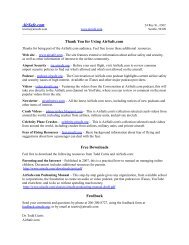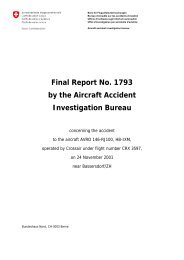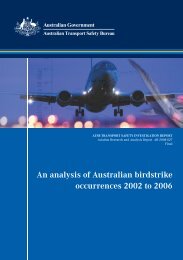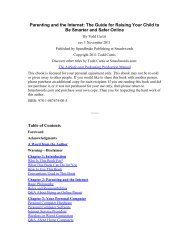AAIB Investigation Updates (PDF) - Airline Safety and Security ...
AAIB Investigation Updates (PDF) - Airline Safety and Security ...
AAIB Investigation Updates (PDF) - Airline Safety and Security ...
You also want an ePaper? Increase the reach of your titles
YUMPU automatically turns print PDFs into web optimized ePapers that Google loves.
<strong>AAIB</strong> Special Bulletin: 1/2008 G-YMMM EW/C2008/01/01<br />
secure location for detailed examination. There were no<br />
indications of any pre-existing problems with any of the<br />
aircraft systems.<br />
debris on its fuel inlet bulkhead. The high pressure filters<br />
were clean. The variable stator vane controllers <strong>and</strong> the<br />
fuel burners were examined <strong>and</strong> found to be satisfactory.<br />
During the impact the right main l<strong>and</strong>ing gear separated<br />
from the aircraft rupturing the rear right wall of the<br />
centre fuel tank. The two front wheels of the right<br />
main l<strong>and</strong>ing gear broke away <strong>and</strong> struck the rear right<br />
fuselage penetrating the cabin at seat height adjacent to<br />
rows 29/30. Additionally, the right main l<strong>and</strong>ing gear<br />
damaged the wing-to-body fairing <strong>and</strong> penetrated the<br />
rear cargo hold, causing damage to, <strong>and</strong> leakage from,<br />
the passenger oxygen cylinders.<br />
The engines, their control systems <strong>and</strong> the fuel system<br />
were the focus of a detailed examination.<br />
Engines<br />
Examination of the engines indicated no evidence of a<br />
mechanical defect or ingestion of birds or ice.<br />
Data, downloaded from the Electronic Engine Controllers<br />
(EECs) <strong>and</strong> the QAR, revealed no anomalies with the<br />
control system operation. At the point when the right<br />
engine began to lose thrust the data indicated that the<br />
right engine EEC responded correctly to a reduction<br />
in fuel flow to the right engine, followed by a similar<br />
response from the left EEC when fuel flow to the left<br />
engine diminished. Data also revealed that the fuel<br />
metering valves on both engines correctly moved to the<br />
fully open position to schedule an increase in fuel flow.<br />
Both fuel metering units were tested <strong>and</strong> examined, <strong>and</strong><br />
revealed no pre-existing defects.<br />
Both engine low pressure fuel filters were clean. The fuel<br />
oil heat exchangers (FOHE) in both engines were free<br />
of blockage. The right FOHE was clear of any debris,<br />
however the left engine FOHE had some small items of<br />
Detailed examination of both the left <strong>and</strong> right engine high<br />
pressure fuel pumps revealed signs of abnormal cavitation<br />
on the pressure-side bearings <strong>and</strong> the outlet ports. This<br />
could be indicative of either a restriction in the fuel<br />
supply to the pumps or excessive aeration of the fuel. The<br />
manufacturer assessed both pumps as still being capable<br />
of delivering full fuel flow.<br />
Fuel system<br />
Several fuel samples were taken from the fuel tanks,<br />
pipe lines <strong>and</strong> filter housings prior to the examination of<br />
the fuel system <strong>and</strong> these are currently being examined<br />
at specialist laboratories. Initial results confirm that the<br />
fuel conforms to Jet A-1 specifications <strong>and</strong> that there<br />
were no signs of contamination or unusual levels of<br />
water content. A sump sample taken from the left <strong>and</strong><br />
right main fuel tanks shortly after the accident revealed<br />
no significant quantities of water. Samples from the<br />
centre tank had been contaminated by fire fighting<br />
foam <strong>and</strong> hydraulic fluid: this contamination was a<br />
consequence of the rupture of the right rear wall of the<br />
centre tank.<br />
A detailed examination of the fuel tanks revealed no<br />
pre‐existing defects except for a loose union in the left<br />
main tank at its inner wall; the union formed part of the<br />
centre tank to left main tank fuel scavenge line. Some<br />
small items of debris were discovered in the following<br />
locations:<br />
1. Right main tank – a red plastic sealant scraper<br />
approximately 10 cm x 3 cm under the suction<br />
inlet screen.<br />
© Crown copyright 2008











